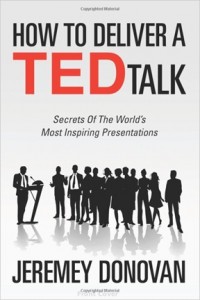 I will assume that most of you are familiar with TED talks. If not, they are basically a forum for ordinary people to share their extra-ordinary stories on a public stage.
I will assume that most of you are familiar with TED talks. If not, they are basically a forum for ordinary people to share their extra-ordinary stories on a public stage.
I recently finished reading “How To Deliver A TED Talk” by Jeremy Donovan. Now before you quit reading just because you have no intention of ever giving a TED talk let me ask you a question. Have you ever wanted to share an idea with someone and actually have them buy into it? Keep reading.
Donovan, a long time spectator as well as participant in TED talks, has done an amazing job in laying out what it takes to deliver a TED talk. This is part 2 of a 2 post series on not just how to deliver a TED talk, but how to tell a story in a way that will move and influence others.
Part 1 focused on the content, story and structure. Part 2 focuses on delivery and design.
HOW TO MASTER YOUR VERBAL DELIVERY
Donovan makes a very clear statement and says that “public speaking should be an amplified version of everyday conversation.” I couldn’t agree more. Nothing is worse that someone reading their speech or sounding robotic in their delivery. The best way to have a conversation is to have a conversation.
Being authentic and personal will allow you to connect. When possible, use the names of the person or people you are speaking to. People love to hear their name. It makes them feel valued.
HOW TO ADD HUMOR TO YOUR TALK
Donovan makes some great points on the value of humor. When we laugh at ourselves, we let down our guard and let the audience know we are just like them. This adds credibility to our words. Exaggerated reality is another good way to get a laugh and connect with your audience. Remember, regardless of the topic, the listeners want to be entertained.
HOW TO MANAGE YOUR PHYSICAL DELIVERY
Your words will carry the content of your speech but your body language will either enhance your message or confuse it. Use body movements to emphasize your emotion but overdo it and you will find everyone focused on what you are doing and not on what you are saying.
HOW TO CREATE VISUALS THAT INSPIRE
For the most part, short and simple is better. I wish I had read this book before delivering my early keynote’s. Too much information again, will take the focus off what you are saying. Donovan provides three different models to choose from and suggests using one or a combination of the three, but not going outside of these deliveries.
HOW TO OVERCOME FEAR
Donovan suggests practicing at least three times as you prepare to deliver your speech. I agree that practice is critical but for me personally, it is actually delivering the speech that helps you overcome the fear. I remember when I first started speaking, how overwhelming it was. What I found was the more I did it, the less I thought about it. The thing I have always tried to remember and Donovan references this throughout the book – it’s just a conversation.
STOP READING AND START SPEAKING
Donovan closes the book with a half page chapter that provides the encouragement to just go do it. Put your fears aside and go tell your story. There are people out there that need to hear it.
You may or may not be a public speaker. You may or may not ever plan to deliver a TED talk. But my guess is that you, at some point in your life, will want to influence someone with your words. This book is a quick, easy read but packs a tremendous amount of content and a framework to be an influential speaker.
I agree with Donovan … Just go do it. It’s time you tell your story.
***********************************************************************
Don’t miss a single post from Building What Matters by subscribing at the top left of this page.
Help support us by clicking here and Liking our facebook page
Barry Smith 6/19/13 photo courtesy of amazon.com © Building What Matters 2013

